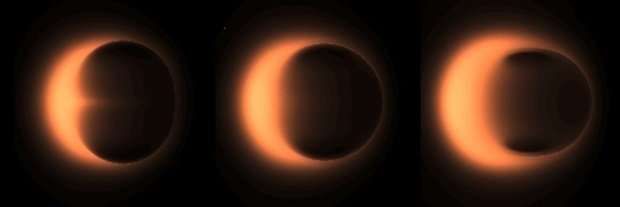At https://phys.org/print458809784.html … looks like at least one country, Japan, is prepared to seriously consider a connection between the solar wind/ earth's magnetic field connection to earthquakes – using the magnetic field to detect future natural disasters (and in memory of the recent tsunami wave that caused the deaths of so many people).
At https://phys.org/print458815392.html … giant planets around young stars raise question about how planets form, we are informed – but are those questions just that. Something to ruminate about or something to explain.
At https://phys.org/print458807652.html … what does a black hole look like? The Event Horizon Telescope has after 4 years produced this image of Sagitarious A, the black hole at the heart of the Milky Way …
 … black holes themselves are invisible. Any light that enters never escapes. However, around a black hole there is light from a luminous swirl of super heated matter yet to fall into the abyss. When light passes near an event horizon it heats and distorts to the pull of gravity. Hence, the picture of this ring of light – circling what is thought to be the event horizon. So, there is no image of the black hole itself – only the sheaf of light (presumed to occupy a postion around the rim of the black hole). Those who vew black holes as in inventive self delusion have to explain the half moon of light in the image above.
… black holes themselves are invisible. Any light that enters never escapes. However, around a black hole there is light from a luminous swirl of super heated matter yet to fall into the abyss. When light passes near an event horizon it heats and distorts to the pull of gravity. Hence, the picture of this ring of light – circling what is thought to be the event horizon. So, there is no image of the black hole itself – only the sheaf of light (presumed to occupy a postion around the rim of the black hole). Those who vew black holes as in inventive self delusion have to explain the half moon of light in the image above.
Another interesting story is at https://phys.org/print458812829.html … life could be spreading throught the Milky Way, from star to star. This is an expansion on the them of Panspermia, first advanced by Fred Hoyle and Chandra Wickramasinghe. In this, micro organisms and the chemical precursors of life are transported through space by meteors, asteroids, and comets. The latter are now thought to be able to traverse from one solar system to another – after the discoery of Oumuamua last year (travelling through our solar system).
The study is ibeing considered by the Monthly Notices of the Royal Astronomical Society, and has the title, 'Galactic Panspermia'. The study, using modelling, determined the entire Milky Way (and even other galaxies) could be exchanging the components for life.
